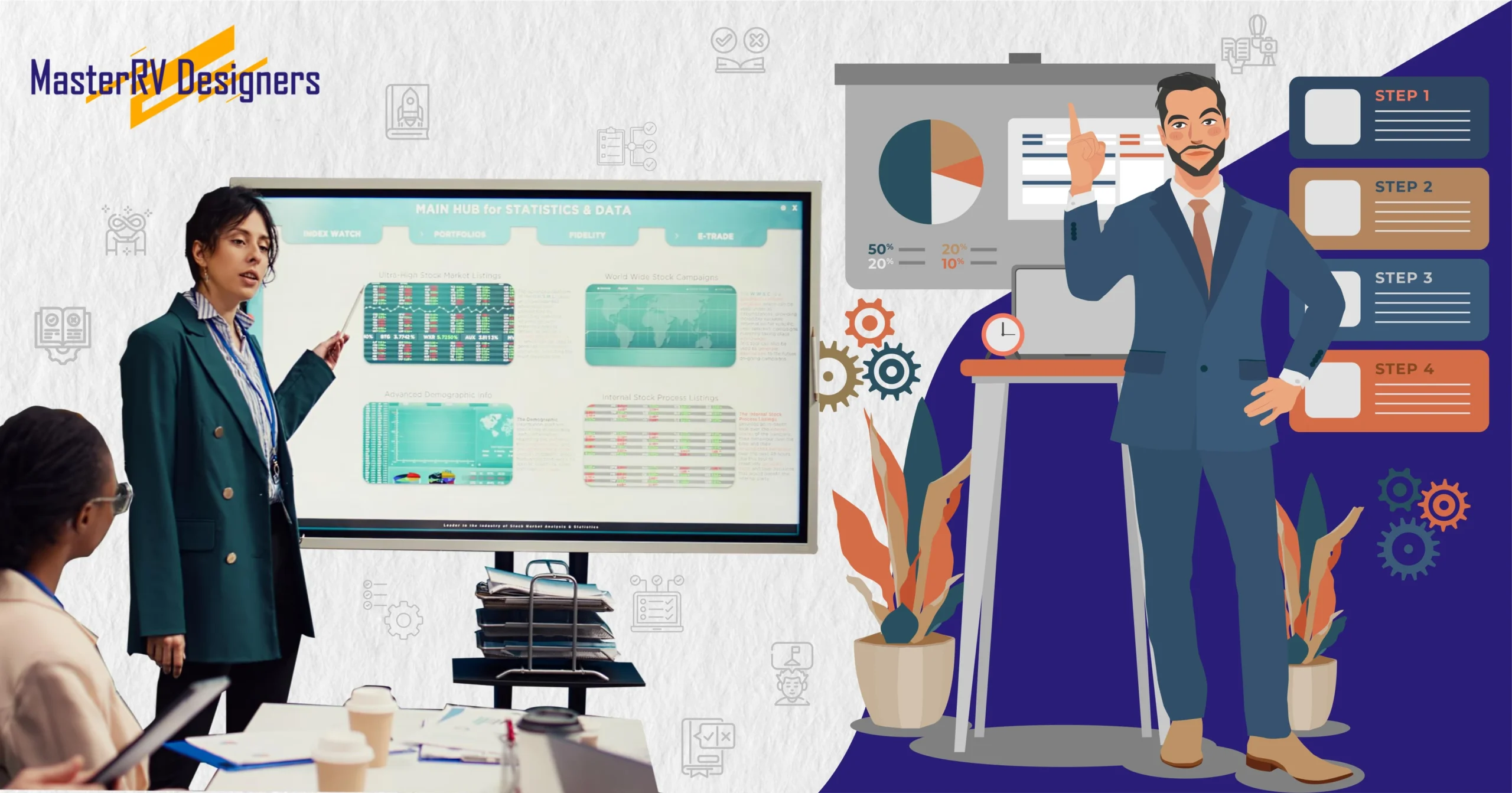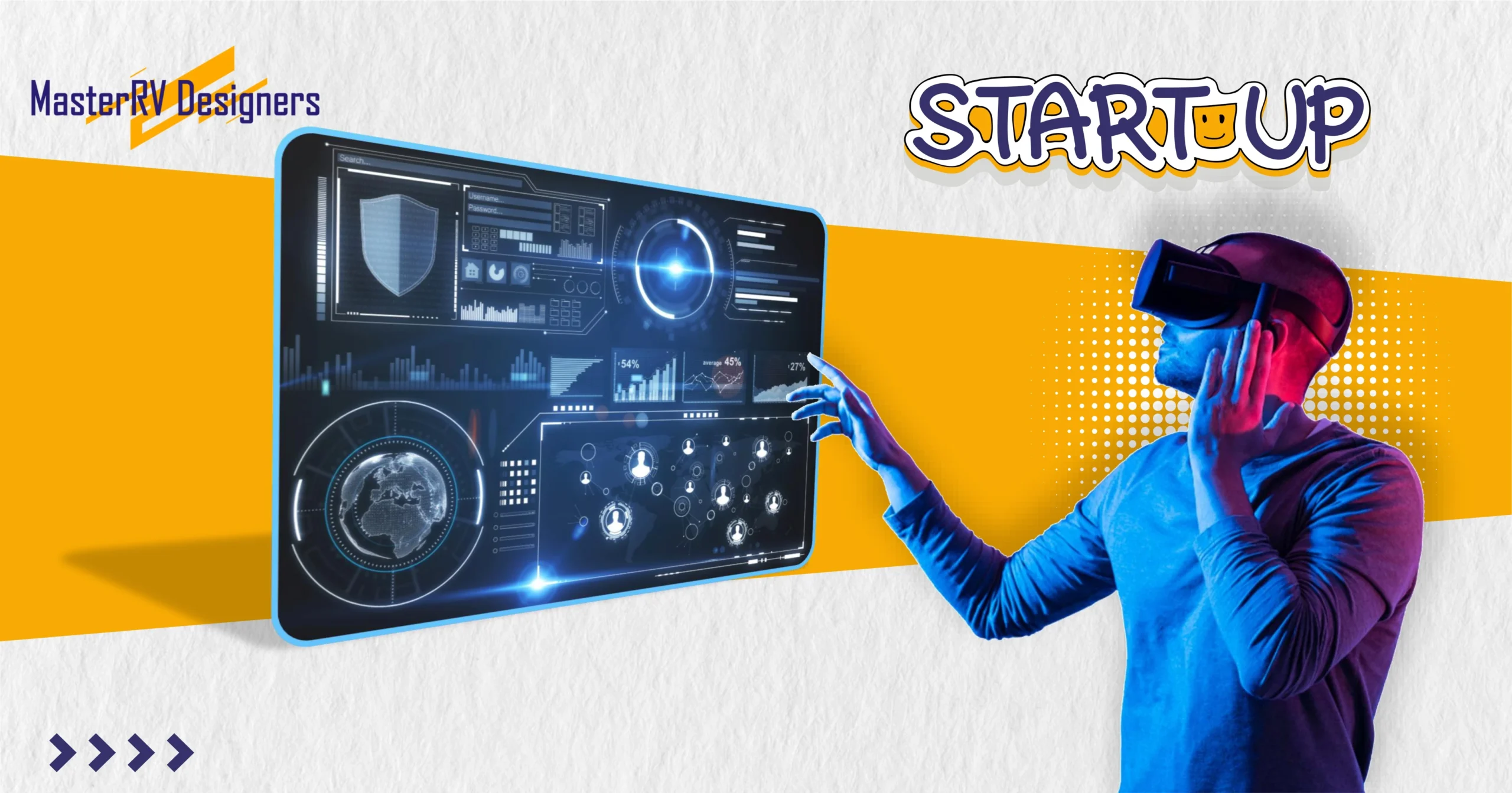TL;DR
Delivering an unforgettable presentation requires more than stunning slides it’s about aligning story, strategy, and presence. MasterRV Designers guides executives, founders, and sales teams in combining design, narrative, and delivery to command attention, engage audiences, and drive decisions. Our coaching covers storytelling, voice, pacing, body language, Q&A, and virtual presentation mastery.
Introduction
The difference between a “good deck” and a “winning presentation” is rarely design it’s delivery. You can have a deck filled with stunning visuals, beautiful animations, and sharp data storytelling, yet still fail to connect with your audience if your delivery lacks rhythm, control, and authenticity. Great presentations don’t just inform they persuade, inspire, and move people to act.
Even the most well-designed slides can fall flat if the presenter doesn’t lead with emotional intelligence and audience awareness. The tone of your voice, the pacing of your message, the pauses between key insights these subtle elements often carry more weight than the design itself. Presentation success depends not just on what you show but how you make your audience feel while showing it.
At MasterRV Designers, we’ve worked with executives, founders, and sales teams across industries who learned that presentation success is 40% visuals and 60% delivery. The visuals create structure, but it’s your delivery that brings the story to life. It’s where credibility is earned, trust is built, and decisions are made.
Your slides tell the story but your voice, timing, and presence make it unforgettable. When your narrative delivery matches the precision of your design, you don’t just communicate you lead.
1. The Hidden Psychology of Impactful Presentations
Every unforgettable presentation taps into three universal psychological drivers clarity, emotion, and credibility. Understanding and mastering these elements transforms a presenter from a communicator into a leader capable of influencing thought and driving action.
Clarity ensures your audience immediately understands what you’re saying and, more importantly, why it matters. Executives and investors process information through a filter of time scarcity; if they can’t grasp your key message within the first minute, you’ve lost their attention. Clear structure and concise storytelling eliminate cognitive friction, allowing your audience to focus on the value you bring.
Emotion creates connection. People rarely remember every data point or slide transition but they always remember how you made them feel. Whether it’s excitement about a market opportunity or confidence in a strategic plan, emotion anchors memory and fuels persuasion. A presentation that connects emotionally converts passive listeners into engaged stakeholders.
Credibility builds the bridge between logic and belief. It’s what transforms a well-delivered talk into a trusted business narrative. Credibility is communicated not just through your data, but through tone, posture, design consistency, and precision in every claim. When audiences sense alignment between your message, visuals, and delivery, they see you as reliable and reliability drives decisions.
MRV Insight: The most persuasive presentations aren’t overloaded with facts they’re architected for emotional rhythm, logical clarity, and visual confidence. Great presenters don’t chase attention; they earn trust through structure, empathy, and authority.
2. Storytelling: The Strategic Core of Every Great Presentation
Powerful presenters don’t recite slides they lead an audience through a strategic journey. Storytelling is the framework that gives logic to your message and meaning to your data. It transforms disconnected information into a narrative that investors, clients, or boards can emotionally and intellectually commit to.
At its core, an effective storytelling arc includes four key stages that align with how decision-makers think:
Context: Begin by defining the challenge or opportunity with precision. What business tension or market gap exists? This stage earns attention by showing that you understand the environment your audience operates in.
Insight: Reveal what others missed or misunderstood. This is where you demonstrate depth the analytical perspective or unique observation that differentiates your solution. Great presenters use this moment to shift the audience’s mindset from curiosity to conviction.
Solution: Present your product, idea, or strategy as the natural and inevitable next step. Here, clarity and confidence are critical show how your approach directly resolves the challenge you introduced.
Impact: End with measurable outcomes and a forward-looking vision. Executives and investors are drawn to stories that connect today’s execution to tomorrow’s results revenue, scalability, or market influence.
This framework ensures every slide serves a purpose and every transition feels intentional. Instead of jumping between data points, you’re building a strategic narrative where logic, emotion, and credibility flow seamlessly.
Leadership takeaway: Storytelling transforms a presentation from data-sharing to decision-making. It’s not about dramatizing facts it’s about structuring information in a way that drives belief and action.
3. Voice, Tone & Body Language: The Visual Design of Delivery
Your delivery is as visual as your slides. Long before your audience processes your data or message, they evaluate your confidence, control, and credibility through how you speak and move. The most persuasive presenters don’t just share information they design their delivery to influence perception.
Think of your voice, tone, and body language as the non-verbal design system of your presentation. Every gesture, pause, and modulation either amplifies or diminishes your authority. The goal isn’t performance it’s alignment. Your words, visuals, and physical presence should all communicate the same story: confidence with clarity.
Best practices for professional presence:
- Maintain eye contact with intention: Connect with individuals in the audience, not the crowd as a whole. It creates authenticity and engagement.
- Use purposeful gestures: Movement should emphasize key messages, not compete with them. Every gesture should have intent and timing.
- Control pacing: Vary your rhythm strategically slow down when explaining a complex idea or delivering an insight, and quicken pace slightly to convey enthusiasm or momentum.
- Refine your tone: Modulate between authority and empathy. A monotone delivery dulls even the best stories; dynamic tone keeps audiences alert.
- Eliminate filler words: Practice deliberate pauses. Silence, when intentional, signals confidence and gives the audience space to absorb your message.
The most effective speakers project calm control the kind that reassures investors, executives, and clients alike.
MRV Insight: The audience reads your confidence before they hear your content. Every presentation is a visual experience, and your body language is part of the design. Shape it with the same precision you apply to your slides.
4. The Rehearsal Framework: From Memorization to Mastery
Rehearsal is where good presentations become great. Yet, many professionals mistake it for rote memorization repeating lines until they sound rehearsed. True mastery lies not in remembering words, but in owning the rhythm and flow of your narrative. Investors and clients can instantly sense when a presenter is reading versus leading.
At MasterRV Designers, we coach leaders to treat rehearsal as performance design a process of refining delivery mechanics until they feel natural, confident, and intentional. The goal is to internalize your message so completely that you can adapt effortlessly to audience reactions, questions, or time constraints.
The MRV 3-Stage Rehearsal Framework
- Stage 1: Dry Run (Structure)
Focus purely on flow. Walk through your deck to ensure logical transitions between slides. Verify that each slide supports the story and no key insights are buried. This run is about alignment not delivery perfection.
- Stage 2: Delivery Run (Tone)
Now refine how your voice carries the story. Practice pacing, emphasis, and emotional modulation. Adjust pauses to match visual transitions and ensure your delivery mirrors the intent of each section calm during data insights, passionate during vision slides, and concise during conclusions.
- Stage 3: Refinement Run (Presence)
Record yourself. Observe posture, gestures, and engagement cues. Small details hand placement, eye movement, stance shape authority perception. This stage transforms nervous energy into composed confidence.
Pro Tip: Recording is your most valuable rehearsal tool. Watch yourself as an audience member would. Identify habits that distract repetitive gestures, filler words, or flat tone and replace them with purposeful control.
MRV Insight: Mastery is achieved when your delivery feels unscripted yet precise. Rehearsal isn’t repetition it’s refinement. Every run should bring you closer to the version of yourself that commands trust, not just attention.
5. Visual & Verbal Harmony: Aligning Slides with Speech
The most compelling presentations operate like a symphony every element, from visuals to voice, plays in harmony. Yet, many professionals unintentionally create dissonance by overloading slides, reading verbatim, or letting visuals compete with their message. The result? Audience disengagement and cognitive overload.
True presentation excellence comes from synchronization ensuring that your slides amplify, not echo, what you say. Each visual should serve as a cue that strengthens your narrative and gives your audience space to think, not struggle to keep up.
Key principles for achieving visual-verbal balance:
- One message per slide: Each slide should carry a single, central idea. Your narration adds depth, explanation, and emotional resonance not duplication.
- Use visuals strategically: Data charts, graphics, and icons should advance your argument, not decorate it. A visual earns its place when it clarifies complexity or drives decision-making.
- Don’t read the slide: Slides are your support system, not a script. Expand beyond what’s shown with insights, anecdotes, or contextual stories that demonstrate expertise.
- Time your reveals: After introducing a visual or key data point, pause briefly. Silence allows your audience to process information and reinforces control over pacing.
When visuals and words align, audiences experience clarity and confidence in your leadership. Misalignment, on the other hand, creates distraction and erodes trust.
MRV Insight: Visual silence can be your strongest design choice. A clean, simple slide especially during a critical message commands more focus and authority than motion-heavy visuals or excessive animation. In presentation design, restraint often delivers the greatest impact.
6. Managing Q&A Like a Leader
For many presenters, the slides end but the real presentation begins with Q&A. This is where composure, command, and credibility are tested in real time. A well-delivered deck may earn attention, but how you respond under scrutiny earns trust.
In boardrooms, investor meetings, and client reviews, Q&A isn’t just about answering questions it’s about demonstrating strategic clarity and leadership maturity. Every response signals how well you understand your business, your data, and your decision logic.
Strategies for success:
- Listen fully before responding: Let the question land. A short pause shows thoughtfulness and confidence, not hesitation. It signals you’re processing, not reacting.
- Bridge tough questions to your narrative: Don’t get trapped in defensive explanations. Instead, acknowledge the concern and connect it to your core message for example, “That’s a valid concern here’s how we approached it in our latest strategy iteration.”
- Use data selectively: A single, well-chosen metric can reinforce authority better than an overload of numbers. The goal is precision, not data dumping.
- Control tone and pacing: Maintain a calm, steady voice even when challenged. Emotional control communicates leadership under pressure.
- End on a forward-looking note: Always close answers with direction “Here’s how we plan to address this,” or “Here’s where we see this evolving next quarter.” It reinforces your proactive mindset.
The best presenters don’t view Q&A as risk; they treat it as validation of command an opportunity to deepen confidence and demonstrate that the deck wasn’t a performance, but a reflection of strategic thinking.
Leadership takeaway: The strongest Q&A answers are not defensive they’re directional. They turn scrutiny into credibility and signal that you lead with clarity, not reaction.
Use Cases: When Clients Work with MRV for Delivery Coaching
Even the most visually stunning presentation loses impact without strong delivery. That’s why organizations across industries from startups to enterprise teams partner with MasterRV Designers to refine not just what they present, but how they present it.
Our delivery coaching focuses on the intersection of communication strategy, design psychology, and executive presence. Each engagement is tailored to the client’s goals whether it’s winning investor confidence, inspiring teams, or closing high-value deals.
Clients partner with MasterRV Designers when they need:
- Investor pitch rehearsals: Founders and CFOs rehearse with our team to master delivery rhythm, narrative pacing, and emotional resonance ensuring funding conversations feel confident and authentic.
- Leadership presentations: CXOs refine how they align voice, tone, and messaging with organizational values. Every word and gesture becomes part of the brand’s leadership story.
- Sales enablement sessions: Teams learn to move beyond features and speak in outcomes crafting product stories that engage, persuade, and convert clients faster.
- Conference keynotes: Executives and thought leaders collaborate with MRV to design keynote sessions that not only inform but inspire, establishing credibility and commanding stage presence.
Outcome:
Our clients consistently report measurable improvements higher confidence in delivery, stronger audience engagement, and a marked rise in presentation-driven outcomes such as lead conversions, investor interest, and content recall rates. MRV’s coaching transforms routine presentations into strategic communication assets that build reputation and influence.
Conclusion
A powerful presentation isn’t defined by how it looks it’s defined by how it lands.
Beyond the visuals lies the true art of influence: the ability to communicate with clarity, conviction, and emotional intelligence.
When story, strategy, and presence come together, your presentation transforms from a sequence of slides into a shared experience one that moves your audience to believe, decide, or act.
At MasterRV Designers, we believe great presenters aren’t born; they’re crafted through intentional design and disciplined rehearsal. That’s why our approach goes beyond decks we coach professionals to deliver with purpose, confidence, and authenticity.
When your delivery aligns seamlessly with your design, you don’t just hold attention you command it.
Forward-thinking leaders and teams partner with MasterRV Designers to refine both ensuring every deck, every story, and every moment on stage drives measurable impact, influence, and lasting memory.
FAQs
1. Can MRV help with presentation coaching, not just design?
Absolutely. MRV provides end-to-end presentation transformation from strategic storytelling and slide design to delivery mastery and stagecraft coaching. Our approach ensures your narrative, visuals, and presence work together to influence decisions and drive action.
2. How long does it take to prepare for a major presentation?
Preparation typically spans 2–3 weeks, depending on complexity, content readiness, and rehearsal cycles. At MRV, we align timelines with your pitch, board meeting, or conference schedule, ensuring you are polished, confident, and fully rehearsal-ready when it matters most.
3. What’s the difference between a good speaker and an unforgettable one?
Good speakers inform; unforgettable speakers inspire action. They balance data with emotion, structure with spontaneity, and authority with empathy. Their audience not only understands the message they remember it, trust it, and act on it.
4. Can MRV support virtual presentation delivery?
Yes. We design and coach for both in-person and virtual presentations. For virtual formats, we optimize visuals, pacing, and camera presence to ensure energy, clarity, and audience engagement are maintained on-screen.
5. Do you train teams or only individuals?
Both. MRV conducts tailored one-on-one coaching for executives and founders, as well as workshops for leadership teams. Our goal is to elevate communication skills organization-wide, ensuring every presenter conveys authority, confidence, and clarity consistently.




